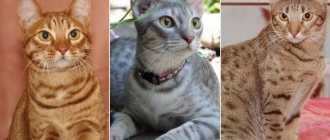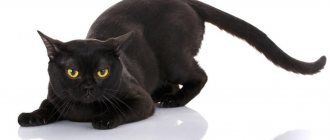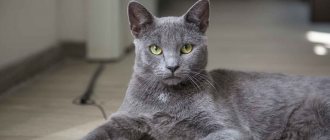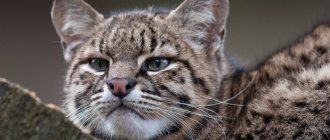Origin story
Close relatives of the Balinese are Siamese cats: it all started with them. Back at the beginning of the 20th century, breeders began to notice that in litters there were kittens of an unusual type: standard color, but with very long fur.
At first, everything was attributed to a genetic mutation, the kittens were discarded and forgotten about. However, in the late 40s, breeder Marion Dorset, captivated by their special elegance and grace, decided to try to breed a new breed. A little later, another enthusiast joined her - Helen Smith.
The breed did not get the name Balinese out of nowhere. Dorset once witnessed the dance of Balinese dancers. After observing their slow, smooth movements, full of grace, the woman compared them with her own cats and realized that the word “Balinese” would best describe them. And the less sonorous “long-haired Siamese” was quickly forgotten.
The breed was registered in 1965, and 2 years later the first official standard was created.
The first Balinese cat was brought to our country in 1988 from Czechoslovakia.
How to choose a kitten
- Before going to visit a breeder, find out whether his nursery is registered with TICA or CFA - this will give a certain guarantee of the quality of the litter.
- Carefully examine the kitten for undercoat. If there is one, this is a significant defect that will not allow him to participate in exhibitions.
- Ask the seller to show the entire litter so you can interact with the kittens. See how the Balinese react to a stranger, whether they are willing to make contact or try to hide.
- Do not contact a breeder who is trying to sell kittens younger than 2.5 months. This suggests that the seller is not interested in the future fate of the offspring and saves on mandatory veterinary procedures (vaccinations, deworming).
- Find out how many times a year the Balinese cat from whom you plan to adopt a kitten gives birth. According to the requirements of European clubs, a cat should produce offspring no more than three times in two years.
- Take your kids' pedigree seriously. In Russia, the number of purebred Balinese breeds is small, and matings with foreign producers are very expensive, which encourages unscrupulous breeders to resort to inbreeding (inbreeding) more often than necessary.
Standards
Balinese cats weigh approximately 4-5 kg, male cats - a little less, 2.5-3.5 kg.
| Standard | Description |
| Scull | Wedge-shaped. The profile is elongated, with a strong, pointed chin and high cheekbones. The nose is straight, large, long enough, without a break on the bridge of the nose. The bite is correct. The neck is thin and long. |
| Ears | Large, triangle-shaped, with sharp tips. |
| Eyes | Oval, outer corners slightly raised. The iris is colored in all shades of blue and cyan. |
| Torso | Slender, with defined muscles, long. The bones are graceful, the belly is tucked. |
| Limbs | Thin, long, with neat oval legs and long toes. The hind legs are slightly longer than the front, but this does not affect the gait. |
| Tail | Long, thin (like a whip), with a plume. |
| Wool | The coat is shiny, smooth, and silky to the touch. The fur on the belly and paws is even, while on the chin, tail and neck it is slightly curly. There is no undercoat. Towards the back, the length of the coat increases. In the area of the shoulders and neck the hair is also long, but it should not form a collar either. |
Disqualifying signs:
- Collar in the neck area;
- Sunken or bulging eyeballs;
- Pale or different eye color;
- Kinks on the tail;
- Excessive number of toes, white toes;
- Thinness;
- Malocclusion.
Many representatives of the Balinese breed have cross-eyed eyes. This is considered a serious fault for which cats are removed from competition.
Colors
There are two dozen existing colors, but major European felinological organizations recognize only 4:
- Blue point: paw pads and nose are gray, points are gray-blue, the main tone is also gray-blue, but of a cooler shade;
- Lilac point (frost point): the body and paws are painted snow-white, but here and there there are stripes and spots of ivory color;
- Shade of chocolate: the main color is “baked milk”, o;
- Seal point: the main color is light beige, with gray or dark brown markings on the tail, paws and face.
In the photo there are cats of the Balinese breed, popular colors.
Some other associations (including American ones) recognize several more colors:
- Torti: a mixture of dark and red;
- Cream: warm shade of light cream;
- Tabby: stripes on body and limbs;
- Ed: red marks.
Kittens are born with light fur, without spots or stripes, and as they grow older the color becomes more typical. Uniformity of color is the main requirement of judges at exhibitions. The entire muzzle should be covered by a mask, but there should not be one in the upper part of the head.
Expert opinion
Dusheba Vera Ivanovna
In 2010, she graduated from the Moscow State Academy of Veterinary Medicine named after K.I. Scriabin with honors, specializing in veterinary medicine. I regularly attend veterinary conferences, congresses, and webinars.
This breed is considered one of the most hypoallergenic: the amount of protein in their saliva is minimal, which means that allergy sufferers can own these animals without fear.
Health
Most breeds are susceptible to chronic diseases and a predisposition to getting them.
- Considering the fact that the breed differs from its ancestors only in the length of its fur, it has also inherited chronic diseases.
- A pet may be susceptible to amyloidosis, this is a disorder of protein metabolism in the body, resulting in a malfunction.
- As a result, amyloids are formed in the liver, which in turn leads to internal organ dysfunction and death.
- To date, a treatment method has still not been found, and the possibility of a pet contracting this disease cannot be completely excluded, because this is the genetics of the breed.
However, if the disease is diagnosed at an early age, it can be significantly alleviated and made almost invisible.
If you provide proper care, your pet may well live from 12 to 15 years or more.
Character and behavior
When looking at Balinese cats, Siamese cats involuntarily come to mind: they are very similar in appearance. But the characters differ like heaven and earth. The Balinese are as affectionate as they are kind. This is a true breed for the soul: they adore people and act like dogs in many ways. In any case, you don’t even need to teach them to follow the owner around the apartment with a tail, bring slippers and wait faithfully at the door. But they don’t like loneliness: they get bored, abandon their toys, and may even get sick. If you spend a lot of time at work, it is better to get a different breed.
He gets along well with other animals: he establishes contact with dogs and cats, and even prefers to be friends with rodents and birds rather than hunt.
Active and cheerful: they love fussing, running around and “standing on their ears.” They completely lack aggression, as well as, by the way, the hunting instinct.
During games they do not bite, do not scratch, and even if they are hurt, they endure until the last. They love to climb to heights and jump down, and while playing with a regular ball they show real acrobatic tricks! Explorers by nature, which means they will climb into every box, open every door and rustle through all the packages and bags.
A quality that can be considered both a “plus” and a “minus” is talkativeness. The love of conversation is in their blood: on any issue they have their own opinion, which they rush to convey to everyone who is nearby. Not a single important event in the house will be ignored: I will look into a book, stick my nose into a bowl of rising dough, watch the drum of the washing machine. But what she especially loves: welcoming guests. The owner’s friend is my friend, the Balinese believes, and he doesn’t mind exposing his back and sides for “scratching.”
Are a cat's pupils the same during the day and at night?
Not really
Walking around the apartment is enough for them, so taking the Balinese outside is unnecessary. Firstly, they are afraid of street noise and cars, and secondly, their resistance to bacteria and viruses is greatly reduced.
You will have to look for kittens of this breed: there are very few nurseries in Russia, and even fewer breeders. But try to find a nursery - this is the only way you will be guaranteed the purity of the breed. The cost of a kitten for the “soul” is approximately 20,000 rubles, and a baby for breeding will cost more – 25-30,000 rubles. Remember: high-quality catteries are required to check cats for genetic pathologies.
Content
Balinese cats are unpretentious to their living conditions. The main thing for them is a warm home, regular feeding, love and respect from their household.
Housing and walking
A Balinese cat will be equally comfortable in a city apartment or in a country house. The main thing is that the room is warm, because the cat has no undercoat and quickly freezes outside during the cold season. In warm weather, the Balinese can be taken for a walk on a leash in a fenced front yard or garden.
It is permissible to take Balinese cats outside, but they also feel comfortable in apartment conditions.
Ideal host
The ideal owner for a Balinese kitten will be an active, cheerful person who will love and care for him. Balinese do not tolerate loneliness well, so owners who disappear at work until late at night are better off getting a representative of a more phlegmatic breed, for example, a Persian or a British one.
Balinese cats will wither away without their owner's attention
Ambient temperature
The optimal temperature in the room for keeping the animal should be between 22 and 24 °C. While staying in a cold room, the activity of a specific gene responsible for color decreases in a cat, as a result of which its fur acquires a darker shade.
In cold conditions, the Balinese's coat darkens
Toys
Balinese, like a small child, constantly demands attention and loves active games. This funny creature will turn any object that comes under its paw into a toy. Toys for a cat should be simple (small balls, plush mice, paper bows on a string), but there should be a lot of them so that the pet does not get bored.
The Balinese will compensate for the lack of games with the owner with tricks of his own taste.
When a cat is bored, he begins an active search for adventure: he jumps on high cabinets, walks along the top shelves, tries to open drawers and take out all sorts of small objects suitable for games.
Video - Breeder about caring for Balinese cats
Care instructions
For a comfortable existence, Balinese people need their own separate bowls for food and water, a tray with suitable filling, a separate bed (open or closed), toys and a play complex (with several levels). The latter is not a whim, but a necessity: there the pet can get rid of excess energy.
Wool
Beautiful wool requires special care: it is long and thin, it often rolls into clumps, which are sometimes very difficult to sort out. Brush your cat 2-3 times a week, first with a slicker brush, and then with a comb with wide rubber teeth.
During molting - daily, using an additional furminator. Bathe as soon as the fur gets dirty, but not too often (so as not to provoke the development of dermatitis and other skin diseases). Use only special shampoo: “Bars”, “Doctor ZOO”. It is better to dry your pet naturally, without using a hair dryer, so that the coat remains shiny and bright.
Don't let your pet freeze! Due to the lack of undercoat, the cat may feel uncomfortable in low temperatures, so avoid drafts and do not walk with the animal in cold weather. A temperature range of +22-25 is just right.
Ears and eyes
Ears and eyes are examined every week. Accumulated dirt and secretions are removed with a cotton swab dipped in a special lotion, chlorhexidine, hydrogen peroxide or fresh chamomile decoction.
Claws
Nails are trimmed once every two weeks.
Mobility
The breed is very active, loves games, is able to find something to do with literally any object, it could be a children's toy, a ball, or a hairpin accidentally thrown on the floor.
The pet will always be happy to play; when he gets bored or tired, he will stop playing and take a comfortable position to rest.
Given her calm nature, she will not be overly intrusive and aggressive even at a young age. Kittens love to play, but they understand perfectly well that if they are careless they can harm a person, so they play carefully. It is for the gracefulness of its movements that the breed received its name.
Catering
Balinese cats are fed the same way as representatives of other breeds: either natural food or ready-made food. It is important to remember that you cannot mix one with the other! It is unacceptable, for example, to pour food into a bowl in the morning and give porridge with meat in the evening. The digestive system will quickly fail. So choose one.
Natural products
As for natural food: you will have to prepare it separately; you cannot feed the animal what you eat yourself: soups, fatty meats, chocolate, yoghurts with additives.
- Meat – only dietary: veal, rabbit, turkey. Fish – sea fish (hake, trout, flounder, salmon), a small piece no more than once a week.
- From dairy products: unsalted hard cheese, natural yogurt, yogurt, low-fat cottage cheese, kefir.
- Porridge – 4-5 times a week (buckwheat, oatmeal, pearl barley, barley, millet), with the addition of boiled or stewed vegetables and half a teaspoon of vegetable oil.
- Give your pet boiled chicken yolk twice a week.
- Fresh and purified water should always be poured into a separate bowl (it is changed in the mornings and evenings).
In order to get rid of balls of ingested hair, cats eat sprouted grains of wheat or oats. You can buy ready-made weed at a pet store or grow it yourself.
You cannot give:
- Human drinks (coffee, cocoa, tea, juices, compotes, mineral and carbonated water) and vitamins;
- Dog food;
- Sweet, smoked, salty, sour, pickled, flour, baked goods;
- Spices and seasonings, sauces;
- Fatty meat, sausages, sausages, tripe, lard;
- Bones;
- River fish;
- Whole cow's milk;
- Eggplants, citrus fruits, potatoes, tomatoes, avocados, grapes, cabbage;
- Legumes.
Recommended food
Ready-made food saves you a lot of time: you go to the store, buy a bag of food and voila! – your pet is already crunching it happily. And you are spared many hours of standing at the stove.
But when choosing food, carefully read the composition. The holistic and super-premium food groups have the most useful ingredients, vitamins and minerals. Holistic: Power of Nature, Pronature Holistic, Wellness CORE. Super premium: Eukanuba, Flatazor, Golosi.
Below are the recommended holistic and super-premium foods. Links with the names of the food are clickable, on them you can, within our website, get acquainted with the descriptions of the food and read reviews from owners of Balinese cats.
| Holistic | Super premium | Super premium |
| Riverwood | Eminent | Matisse |
You should switch from one menu to another carefully, gradually offering new food and observing the animal’s condition. If the cat begins to have a long-term bowel disorder or vomiting, stop the experiment.
Diseases
This breed is in good health - alas! – can’t boast. The most common ailments:
- Strabismus (this problem can be obvious or smoothed out, but one thing is known: you cannot get rid of it);
- Cutaneous asthenia is a pathology in which the skin becomes so thin that it is injured even with normal movement;
- Asthma - it is caused by some allergen;
- Esophageal achalasia – the esophagus increases in size, causing the cat to belch, vomit, and have abdominal pain;
- A defect of the heart muscle is detected in kittens. There is no treatment;
- Amyloidosis of the liver and kidneys is a common disorder. The disease cannot be cured, but supportive therapy and diet can significantly prolong the life of a pet.
In addition, Balinese cats are more prone to cancer than others: lung cancer, mammary cancer. Elderly people often suffer from diabetes.
Puberty in males occurs at 9-10 months, in females sometimes earlier. However, you should not “breed” animals under one and a half years old. Give them time to gain strength. Keep in mind: during the rutting period, the cat becomes not herself: she can roll on the floor, scream, tear up walls and throw herself at doors.
If you do not plan to breed, consult a veterinarian and he will tell you what operation should be performed in your case. But various kinds of drugs - both drops and tablets - do not work well.
Raising a Balinese cat
Talkativeness is a feature of all oriental breeds. If you are not ready for daily conversations, then it is better not to get a Balinese cat. Not all owners know how to properly raise these animals and have difficulty understanding the signals of their pets. Some breeders mistake sadness for aggression, isolating the poor cat in a separate room in the hope that he will calm down. Any isolation is detrimental to the psyche. An animal that does not receive enough affection and understanding from its owner may begin to mark its territory, scratch walls, or chew inedible objects.
If you are ready to communicate and a cat’s meow is one of your favorite sounds, then don’t worry. Raising a furry pet will be successful, as it lends itself well to training in a play format. Teaching manners should begin in early childhood, and familiarization with commands should begin at an older age, that is, no earlier than six months. Try to be tactful so as not to hurt the animal's feelings. Undeserved punishment can be very hurtful, so reinforce interest in learning with rewards.











